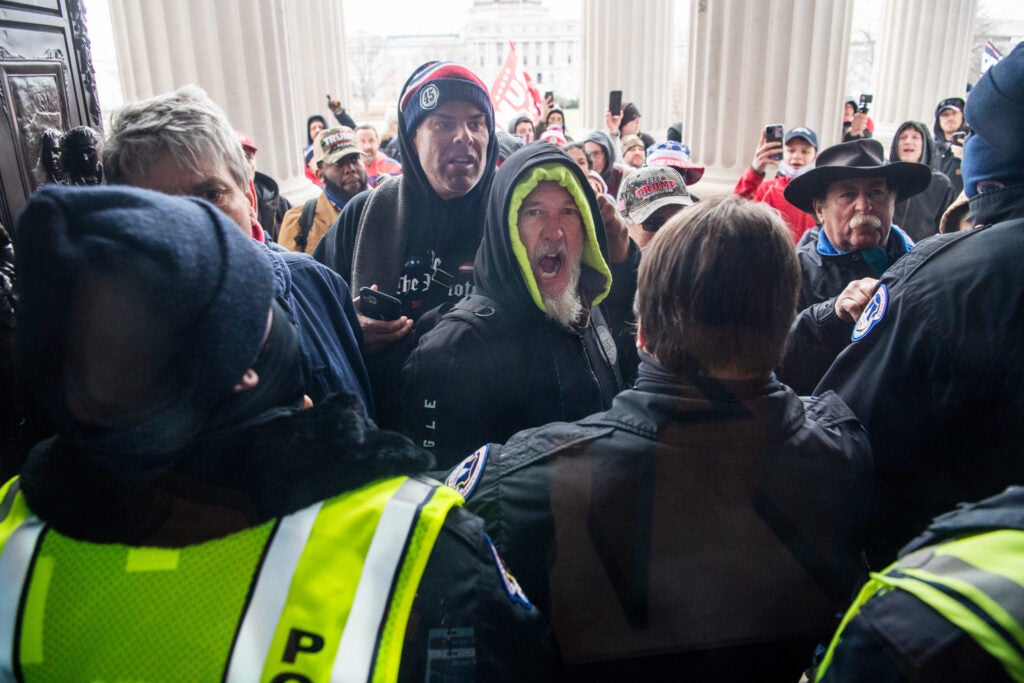via Harvard Law Today
by Jeff Neal

“Implicit bias” played a major role in the “massive breakdown in preparation” that led to the U.S. Capitol being breached by a hostile force for the first time since British soldiers set it alight in 1814, said Harvard Law Lecturer James E. Tierney, who served for a decade as Maine’s Attorney General.
Had Wednesday’s demonstrations in Washington, D.C. involved peaceful Black Lives Matter protesters advocating for racial justice instead of right-leaning supporters of President Donald Trump, he believes, the U.S. Capitol Police would have been much more prepared to employ “physical responses at the slightest provocation.”
In the days since members of Congress were forced to shelter in place as largely white, pro-Trump demonstrators roamed the marbled halls of the U.S. Capitol, many carrying confederate flags and visibly armed, observers have noted the sharp contrast between law enforcement’s passive response and how many police departments in D.C. and elsewhere actively confronted mostly peaceful Black Lives Matter protesters this past summer. In an interview conducted by email Thursday with Harvard Law Today, Tierney, who currently teaches courses on the role of state attorneys general, discussed police response and reform.
Harvard Law Today: What went through your mind when you saw rioters pushing past police to break into and occupy the U.S. Capitol?
James Tierney: My first reaction was the one of total disbelief that we all shared. After all of ten seconds my mind became professional and I thought “massive structural breakdown in preparedness.” It was painfully obvious.
HLT: Echoing many other observers, conservative pundit David Brooks argued this week that: “The rampage reminded us that if Black people had done this, the hallways would be red with their blood.” Do you agree?
Tierney: I agree totally with Brooks, but the cause of this disaster arose long before the Capitol building was breached.
Bluntly, if the Capitol Police knew a Black Lives Matter march of thousands of protesters were marching down Pennsylvania avenue, their implicit biases would have resulted in a very different kind of preparation. They would have pushed the fences back and been waiting in full riot gear. Their batons would have been at the ready and they would have had plenty of back up. Their predisposition to a Black Live Matter march would undoubtedly have led to assertive and physical responses at the slightest provocation.
Credit: Martha StewartLecturer on Law Jim Tierney at the 2019 AGTech Forum at HLS.
Instead, as the Capitol Police readily admitted Thursday, they were waiting for “peaceful First Amendment protesters.” Despite all evidence to the contrary and the president’s obvious incitement to violence, the implicit bias of the Capitol Police leadership kept them from seeing the facts before their eyes.
The Capitol Police leadership evidently expected nice pro-Trump folks – who were virtually all white – who would arrive to wave the American and confederate flags and sing patriotic songs. So, what could go wrong?
Once the incident began, the Capitol Police still did not call for the available back up from the Washington, D.C. police, the FBI and the National Guard. Some reports say they turned it down. Overwhelmed as the result of their own blindness, at that point they just stood back and let it happen.
Once the building was penetrated, the Capitol Police focused on protecting the members of the Congress and their staffs. This was the right thing to do as protecting human life is always the highest priority.
HLT: Was this a one-off incident, do you think, or is there precedent or even a historical pattern of law enforcement showing more leniency to white protesters?
Tierney: Yes, there is a historical pattern, but the focus of the discussion must be on the biases that formed the expectations of those in charge. Clear-eyed advanced planning at the top is essential, and that obviously was lacking.
HLT: Where is the line, then, between peaceful protest and illegal, or even riotous, activity? What line should all protests and protesters be held to?
Tierney: All protesters should be held to the same standard and it is a pretty simple rule. Peaceful protest is legal. Non-peaceful protest is illegal. That is the bright line.
HLT: What, if anything, can be done to create a more equal and just playing field for all people, regardless of their backgrounds or causes, who are trying to exercise their First Amendment rights, while protecting people and property from violence and destruction?
Tierney: In this case, the entire leadership of the Capitol Police should be removed. More important, the congressional committee in charge of security for the Capitol should take active steps to make sure that the force is led by those whose eyes and minds are truly open, and that this approach should extend to any building that is the likely destination of organized demonstrations.
Filed in: In the News
Tags: Jim Tierney
Contact Office of Clinical and Pro Bono Programs
Website:
hls.harvard.edu/clinics
Email:
clinical@law.harvard.edu